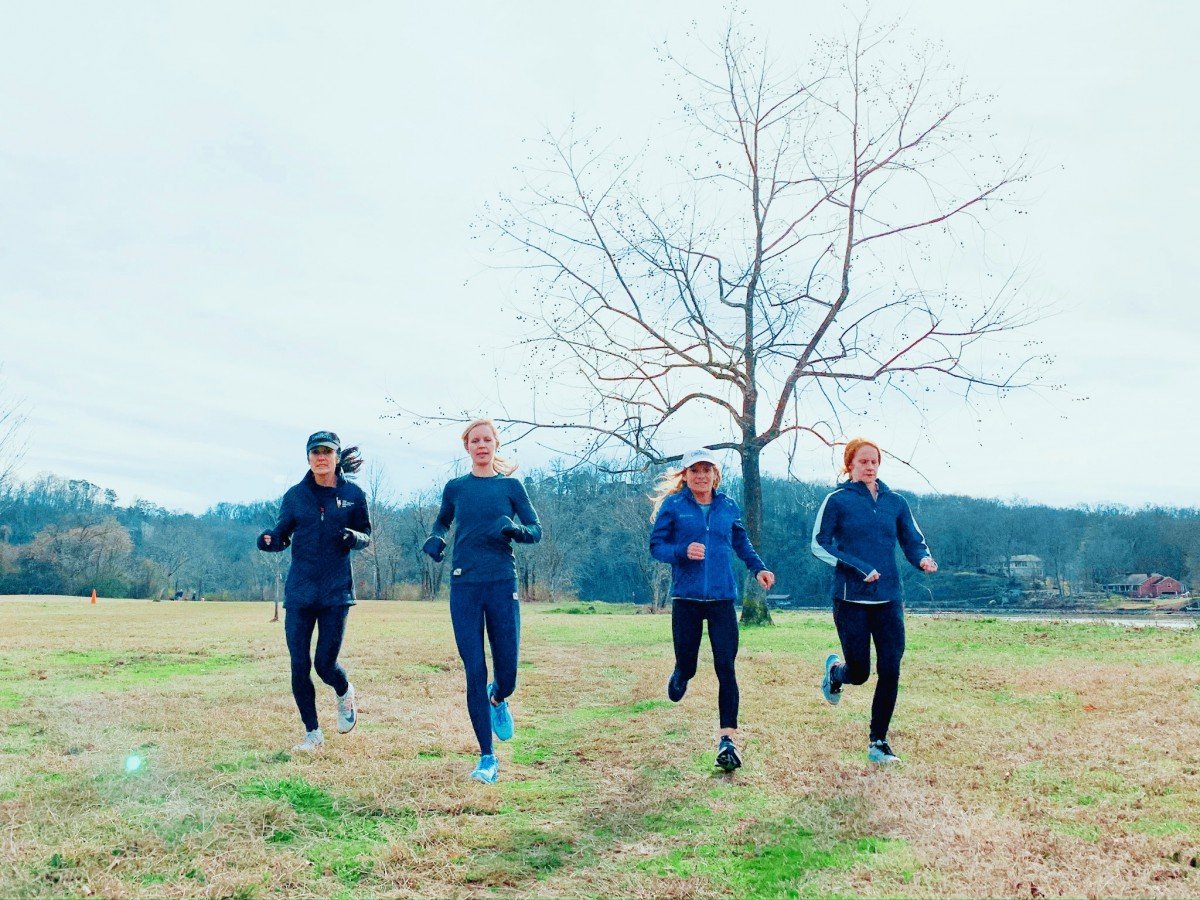How Long Does It Take to Lose Running Fitness?
Rome wasn’t built or lost in a day. And either is your running fitness. Just as it takes time to build your running fitness, it takes time to lose your running fitness. Even taking two weeks off from running, will barely make a difference (2.7%) in running shape. Plus, what you do lose, comes back quicker. Read more about how long it takes to get out of shape, and how to get it back.

Over the past 5 years, I have had to take so many breaks over due to major running injuries that I am constantly asking myself: how long does it take to lose running fitness? Subsequently, I’ve had a lot of mother runners ask me that same question when forced to take time off due to injury, illness, or LIFE.
Table of contents
For me, I had to take almost a year off for my hamstring tear and resulting high hamstring tendinosis. Then I had to take more extended time off due to three bouts of complications from COVID, a torn plantar fascia, and a torn hip labrum. After almost three years of no running, I was able to rebuild from scratch and run a 2:58 marathon and a 2:54 marathon in the span of 10 months.
With all these breaks from running, I know firsthand how much time it takes to lose fitness running and how long it can take to build back.
How long does it take to lose running gains?
In short, it takes about TWO WEEKS of doing completely nothing for fitness to decrease by a statistically significant amount.
It is so hard not to freak out and worry about all the fitness we’re losing when we aren’t pounding the pavement or hitting the track. But take heart. Science shows that all the time and effort you put into your running; fitness isn’t lost in a day or even weeks. Just as it takes time to build, it takes time to lose. Our bodies work in long-time scales in both directions.
Famed running coach Jack Daniels (whose program I became a certified coach under) takes into account all the physiological variables that go into losing running fitness (including VO2 max, lactate threshold, speed, and running economy).
Key takeaways from the research show that:
- It takes about two weeks of total rest to lose any statistically significant amount of fitness.
- Current fitness is easily maintained with even just a couple of short sessions a week (of at least 13 minutes).
- The fitter you are, the easier it is to get your fitness back.
- Still, the first couple of runs back will feel rough as your body adapts and your running economy improves.
- It’s important to start back gradually (easy mileage with strides) before resuming training.
FAQs about Losing Fitness
Can you lose running fitness in a week?
You lose running fitness of less than one percent in a week.
How much running fitness will I lose in 2 weeks?
You will lose less than 3 percent of your running fitness in two weeks off running or cross-training.
Can you lose running fitness in 2 days?
No, you will not lose running fitness by taking two days off running.
According to Daniels, this is how long it takes a runner to lose running fitness:
0-5 days off running: no change
7 days off running: 0.6% change
14 days off running: 2.7% change
28 days off running: 6.9% change
72 days off running: A runner is almost completely detrained.
4 Truths of How Long It Takes to Lose Fitness
1. Your body does go through metabolic changes when you detrain.
Let’s get to the bad news first.
When you take time off, adaptations do happen in the body that makes your use of energy less efficient, thereby leading to slower running and more discomfort.
A 2000 study in the journal Sports Medicine, followed athletes who didn’t exercise much over 4 weeks. After about one week of inactivity, they started to notice the following changes:
- a reduction in capillary density and oxidative enzymes which impacts how much oxygen your body can process;
- along with a rise in how much oxygen a person then consumes over carbon dioxide produced;
- a decrease in glycogen uptake and an increase in fat-burning (which leads to slower running); and
- an increase in fast-twitch muscle fibers over the use of slow-twitch muscle fibers, leading to a faster accumulation of lactate leaving your legs burning and heavy.
- Additionally, other factors outside this study such as a decrease in muscle tension and neuromuscular changes can lead to a decline in running performance.
- A 1985 study in the Journal of Applied Physiology found a 9 percent reduction in blood volume and a 12 percent reduction in stroke volume after two to four weeks of inactivity in trained men. This impacts your VO2 max, making running feel hard.
Overall, after more than a week off, your running economy decreases short-term as the nervous and biomechanical systems get less efficient.
But don’t drown your sorrows in a jar of peanut butter yet—I mean, for goodness sake, eat the peanut butter but don’t cry over it! There’s good news!
2. It’s easier to regain fitness after you’ve lost it.
Yes, while you may have a small decrease in aerobic fitness, speed, and running economy, your fitness remains just below the surface. Thus, it takes less time to get it back than it did to get it in the first place.
As Daniels writes in his iconic book Daniels’ Running Formula, “it’s easier to regain a level of fitness than it is to attain it in the first place. You’ve been there before, so experience is on your side.”
Those biological changes (such as neuromuscular efficiency and capillary and mitochondrial density) you worked so hard for don’t completely reverse as soon as you stop hitting the pavement.
According to Daniels’, it takes about two and a half months of detraining (or complete inactivity) for you to reverse the biological adaptations of your training. Also, some studies show there is a sharp decline around two weeks of detraining which progresses for about two months, but then the decline slows.
Plus, there’s this:
3. The fitter you are, the easier it is to bounce back.
This goes back to all the changes within your body that you’ve triggered with your hard work. It’s become super energy-efficient. Additionally, the nuclei in your muscles remain intact, finds a 2019 review in the Frontiers of Physiology. Thus, it just takes a bit of time to reactivate them. (More on how to do that is below.)
4. It’s easy to maintain current fitness.
A lot of these studies show a decline in fitness study participants who do zero cross-training or aerobic conditioning. (Cross-training does slow the rate of which you detrain!). Thus, it’s easy to believe it’s all doom and gloom when sidelined.
But take heart.
Studies, like this 2021 article in the Journal of Strength and Conditioning Research, have found that endurance performance can be maintained for 15 weeks on as little as two sessions per week, or a reduction in volume of up to 66 percent with sessions as short as 13 minutes!
In general, volume and frequency can be more than halved as long as there is some intensity in the workouts. Reintroduce volume and intensity, and you’re back where you started after just a couple of weeks!
For VO2 max in particular, a 1985 study in the Journal of Applied Physiology had athletes cut training volume from six to ten hours a week to just one 35-minute session. Amazingly, those athletes had no reduction in their VO2 max.
However, their performance did decrease likely due to the physiological changes noted earlier in this article.
Unplanned breaks can end up giving you fitness gains
In a fantastic 2021 Trail Runner Magazine article by amazing running coach & GOAT David Roche of Some Work, All Play Running, Roche points out that many breakthroughs come from breaks. Why? Because these breaks can allow your body to recover and build back up again before resuming training.
“If you play your cards right, breaks can lead to exponential growth processes that reset what you could have ever thought possible before the layoff,” writes Roche. “A few days on your butt could heal muscles, balance hormonal fluctuations from hard training and stoke the motivation fire. After a short time off, you may even be stronger than you were in ancient times (a few days prior) when you were able to run.”
Running constantly forces us to be in the moment—even when not running. Take the time to heal with peace knowing that any fitness you lose will come back fast, and you will be stronger in body and mind when you do.
Have you had to take a break from running? If so, what was your return like?






